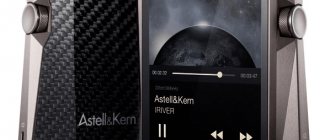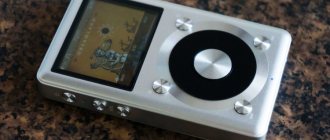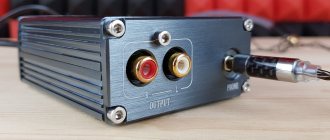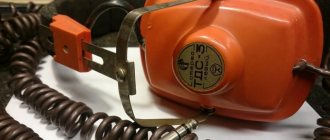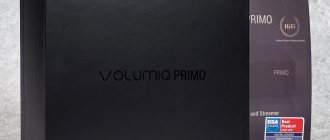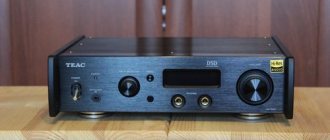Hello Giktimes! True audio connoisseurs know that the 380 is not only Airbus (by the way, the largest passenger aircraft in the world), but also a real flagship among audio players from Astell&Kern. In certain circles, this device needs no introduction, and only a few manage to touch this miracle of audio technology. It was all the more interesting to get to know him - after all, players for 250 thousand rubles do not fall into the hands of even “people in the know” every day. Let's go to the cut, at least let's look at the pictures
For some reason, some are embarrassed to start a conversation about the premium segment, but in vain: if expensive materials are used as body materials, and the device itself is a symbiosis of dozens of patented solutions, it is not surprising that its final price is appropriate. Of course, premium comes in different forms: for some it’s headphones for 50-60 thousand rubles like the Fostex TH-610 (which we’ve already reviewed), for others it’s Audio-Technica for 100 thousand rubles and more, and still others have their say “premium” even starts from several hundred thousand. The latter include our today's guests from Astell&Kern - the AK380 player and Angie II headphones.
At one time, in the world of portable Hi-End, few could compete with the Colorfly C4; true audiophiles remember this very well. But as soon as he retired, whoever tried to take his place: both iBasso and even Sony made their attempts. The devices they offered were quite good, however, no one was able to seriously declare their leadership. And suddenly an unexpected guest from the East appeared on the stage - Astell&Kern.
This Korean company owes its appearance to Samsung, from where several engineers left in 1999 to create their own company with the intention of producing... mp3 players. You shouldn’t be surprised; at that time, although these devices were not at the peak of their popularity, they were already in incredible demand. The result was iRiver, which quickly burst onto the market and managed to establish itself as a manufacturer of inexpensive, but at the same time high-quality players, because they supported not only MP3, but also OGG. Well, admit it, everyone had an airiver?
Everything would be fine, but just as quickly iRiver’s competitors appeared in the form of Apple with its iPod and Sony, which in a couple of years moved from the horizon to the foreground. Against their background, users began to forget about the once beloved brand.
However, iRiver was not at a loss and began to do the most sensible thing in such situations - look for a free niche. And no, they didn’t start churning out headphones for a few dollars: instead, they decided to break into the niche of portable Hi-End, which was later dubbed “super-expensive.” The risk, of course, was huge - entering a new market with an unknown brand, and even without a portfolio of engineering solutions. But those who don’t take risks don’t drink Russiano, and now Astell&Kern can easily fill a 50-meter swimming pool with this drink.
The first pancake did not turn out to be a problem for the new brand - the Astell&Kern AK100 was received by customers cordially and with interest, so the company decided not to stop there.
Every year, Astell&Kern improved technical solutions, complicated the devices, making them more and more expensive. This is how the AK240 appeared, which already cost over $3,000 and, despite the high price, was in incredible demand.
It would seem that this is the pinnacle of success, and you can stop. But it seems that there is simply no such word in the Korean dictionary. After all, this is why we are telling you about the AK380 today.
The audio player was presented by Astell&Kern in May last year and in this short time has earned itself the title of one of the most accurate music playback devices that exist on the market today.
Equipment
The stylish black box hides the AK380 itself, which at first you carefully take with four fingers, despite the fact that it is conveniently removed from the box using a “tab” - here we say hello to Apple and its MacBook. In general, the “open the box and immediately see the device” approach was first tested by premium brands, then the rest caught up, which previously hid the device itself with a lot of cardboard, warranty cards and other waste paper.
The side lines of the box accurately repeat the geometry of the AK380 body, which makes it quite futuristic. Inside are two more black boxes - the larger one contains the necessary documentation, a set of films and a stylish brown case made of hand-made genuine leather. The small box contains a place for a micro-USB cable for charging and transferring files.
The package is built on the principle of “nothing superfluous”. Everything is in its place, just a paradise for a perfectionist. I don’t even want to throw away such a box, but we won’t sing its praises for a long time - we’d better look at the player itself.
Appearance
You can love Astell&Kern for the design of its devices alone. But the AK380 body is something incredible: so much so that at first you just get stuck on the player, trying to find the right words (or rather even epithets). Three came to mind: elegance, futurism and innovation. The appearance of the player's body is very unusual - it is not a remnant or a familiar rectangular block, but at the same time, all the edges are quite sharp.
The body is made of aircraft-grade duralumin, although from the photographs you might sometimes think that wood is used as a material. No, only expensive metal and carbon fiber that covers the back of the player. The manufacturer characterizes the color as “Bright Titan” (Meteoric Titan): in combination with materials, it changes from copper to graphite depending on the angle of incidence of the light. The edges are chopped, which makes it difficult at first to understand what the actual dimensions of the device are. Since the buyer places the highest demands on a player of this level, it is not surprising that the case is thought out to the smallest detail - so that it is not only beautiful, but also convenient to use. Dimensions of 112x80x18 mm and a weight of only 230 grams make the device comfortable; the player easily fits in the palm of your hand and does not slip out.
The front panel of the player is represented by a four-inch screen with a resolution of 480×800. Although it is touch-sensitive, the manufacturer did not disdain physical buttons - the solution is somewhat reminiscent of the Apple Watch, which provides control both from the display and using the side “wheel” of the Digital Crown. The AK380 instead has a volume wheel located on the right edge. There is also a slot for microSD memory cards - in case the built-in 256 GB is not enough for you. The carbon back also has a nice bonus - a screw with which you can fasten the amplifier.
On the left side there is a playback control unit, consisting of three keys - two buttons for switching between tracks and a Play/Pause button. On top are two headphone outputs (regular 3.5 mm jack and balanced 2.5 mm) and a power button.
But it wouldn't be Astell&Kern if it didn't hide something weird in the case. In the case of the AK380, this is a touch key recessed directly into the aluminum case. The button is located just below the screen and responds precisely to clicks - the sensor is able to recognize them from a normal touch. Looking ahead, we note that it works almost flawlessly.
All products made from this material
Astell&Kern PSF11 Layla - in-ear headphones (Black)
Product removed from sale Article: 345894
Item in your cart
Astell&Kern AK380 256Gb - digital player (Meteoric Titan)
Product removed from sale Article: 343463
Item in your cart
Astell&Kern AK320 128Gb - digital player (Gunmetal)
Product removed from sale Article: 488999
Item in your cart
Bundle Astell&Kern AK320 128Gb (Gunmetal) + Audio-Technica ATH-MSR7 (Black)
Product removed from sale Article: 611980
Item in your cart
Characteristics of AK380
We will specifically examine this point of the review in more detail. First, let's go over the main parameters and sound characteristics using summary tables.
Main settings
| Housing material | Aviation duralumin |
| Color | Meteoric Titan |
| Display | 4″ WVGA (480×800), touch |
| Supported Audio Formats | WAV, FLAC, WMA, MP3, OGG, APE (Normal, High, Fast), AAC, ALAC, AIFF, DFF, DSF |
| Sampling frequency | PCM: 8 - 384 KHz (8/16/24/32 bits per sample) / native DSD: DSD64 (1 bit 2.8 MHz), Stereo / DSD128 (1 bit 5.6 MHz), Stereo |
| Output level (no load) | 2.2 Vrms (unbalanced output) / 2.3 Vrms (balanced output) |
| DAC | AKM AK4490 x 2 (dual DAC) |
| Decoding | Support 32bit/384kHz bit decoding |
| Entrance | micro-USB type B |
| Exits | Optical (3.5 mm), balanced (2.5 mm, 4-pin only) |
| WiFi | 802.11 b/g/n (2.4 GHz) |
| Bluetooth | 4.0 (A2DP, AVRCP, aptX) |
| Nutrition | 3400 mAh, lithium polymer |
| Dimensions | 79.8 x 112.4 x 17.9 mm |
| Weight | 230 g |
| Built-in memory | 256 GB (NAND) |
| Additional memory | microSD up to 128 GB |
Sound options
| Frequency response | ±0.053 dB (20 Hz - 20 kHz), unbalanced and balanced output Unbalanced: ±0.56 dB (10 Hz - 70 kHz) Balanced: ±0.55 dB (10 Hz - 70 kHz) |
| Signal to noise ratio | Unbalanced: 116 dB/kHz Balanced: 117 dB/kHz |
| Crosstalk | Unbalanced: 130 dB/kHz Balanced: 135 dB/kHz |
| KGI + N | Unbalanced: 0.0008% @ 1 kHz Balanced: 0.0007% @ 1 kHz |
| IMD SMPTE | Unbalanced: 0.0007% 800Hz 10kHz 4:1 Balanced: 0.0006% 800Hz 10kHz 4:1 |
| Output impedance | Balanced output 2.5 mm: 1 ohm Headphone 3.5 mm: 2 ohm |
The characteristics of the AK380 are truly flagship: the reproduced audio indicator is 32 bit/384 kHz instead of 24 bit/192 kHz, reproduction of the original sound, and not the converted original one with a reduced sampling rate.
You hear the music the way it was meant to be heard, without any reduction in resolution. The difference between the 32-bit playback of the AK380 and other players is clearly illustrated by the images below. AK380:
Other players: The Astell&Kern AK380 also uses a parametric equalizer - it is controlled by a separate processor and provides sound adjustment with an accuracy of 0.1 dB for each band. The DSP takes on all the functions of signal formation and filtering.
The player's parametric equalizer is 20-band, unlike the AK240, which has a 10-band equalizer. This allows you to cover more frequencies compared to its predecessor.
Another feature of the AK380 is a high-precision Femto Clock generator with 200 femtosecond jitter and VCXO. The latter sets the oscillation frequency using an input signal, and adjusting the input voltage allows you to adjust the exact frequency value.
We can’t say that we were surprised to see a high-precision generator in the player - after all, this is one of the indicators of expensive audio systems, and here we have a representative of the very premium segment. In this case, it is worth paying attention to the value of jitter - the error that occurs in the reference frequency, which is needed to perform sampling. The amount of jitter in the AK380 is very small (a femtosecond is one quadrillionth of a second), Femto Clock provides better correction and adjustment of a more accurate frequency value.
Just as the creators of the player decided not to skimp on case materials, they also did not skimp on the technical equipment of the player, so that it could perform its main task - high-quality sound reproduction - better than anyone else. There are separate AK4490 DACs for each channel, support for DSD 64 and DSD 128 formats, sampling rates of 384 kHz - this is something you won’t see in many stationary Hi-Fi systems even nowadays.
The player can even work as an external USB DAC - a special mode is provided in the menu for this. If you use a balanced connection, you can achieve maximum results for line output mode. Tests carried out using RightMark Audio Analyzer clearly demonstrate that the value of some parameters is even higher than stated by the manufacturer.
The maximum signal-to-noise ratio of 123 dB is achieved by installing two AK4490 DACs in mono mode - an indicator that is almost prohibitive. The interference of non-linear distortions when playing a file with a sampling rate of 44.1 kHz is minimal.
The ultimate dream
Portable player Astell & Kern AK380 Price - RUB 267,990.
Astell & Kern's top-end portable player has already appeared in one of our group reviews. However, the interest in the most expensive of the mass-produced pocket players is great and makes us return to it again. Moreover, its next premium modification, Copper Edition, was recently released, and very soon the AK380 will appear in a new black color.
Unlike inexpensive portable players, the market for such high-end devices has remained largely unaffected by the onslaught of smartphones. The sound quality of even flagship communicators is not capable of satisfying the discerning music lover, so specialized gadgets with a good level of musicality remain beyond competition. There has even been a certain generalized image of such a device - usually these are large, weighty blocks with a minimal set of functions, an extremely primitive interface and packaged in clumsy cases, to which no designer was allowed. They usually cope well with their immediate task, but in many, albeit minor, but important aspects they leave much to be desired. Astell & Kern specialists did everything to ensure that their beloved brainchild was as perfect in every respect as possible today.
It is impossible to confuse the Astell & Kern AK380 with anything at first glance. The characteristically faceted case with an asymmetrically located display and a volume control similar to a giant wheel of a mechanical watch is easily recognizable and evokes due respect among audiophiles. The strict lines and classic impressiveness are somewhat diluted by a carbon insert on the back side, but if desired, it can be hidden under a genuine leather case, in which the device will harmoniously fit into a gentleman’s set of status accessories. In addition to the standard blackened aluminum, there is a special version of the device - Copper Edition made of real copper. The exclusive design option will cost even more.
It is impossible to confuse the Astell & Kern AK380 with anything at first glance. The characteristically faceted case with an asymmetrically located display and a volume control similar to a giant wheel of a mechanical watch is easily recognizable and evokes due respect among audiophiles. Access to the wide functionality of the device, which is completely different from the ascetic equipment of other specialized players, is provided by a 4-inch touch screen with a graphical menu, including in Russian. Made using AMOLED technology with a resolution of 480x800, it would decorate any smartphone. There are Wi-Fi and Bluetooth 4.0 wireless interfaces, so the device fits seamlessly into a home media network. A parametric 20-band equalizer based on a DSP processor allows you to customize the sound to suit your personal tastes and the characteristics of the headphones you use within a wide range. The entire audio path, starting with a pair of the latest Asahi Kasei Microdevices AK4490 digital-to-analog converters, is built according to the “dual mono” scheme. Conversion of material into analog form is carried out in the 32-bit / 384 kHz standard. Work with DSD stream up to 5.6 MHz occurs natively, without conversion to PCM. Such abilities not only guarantee immediate relevance, but also serve as a powerful foundation for the future.
Instead of the sketchy mushy mass into which the good old Walkman turned a symphony orchestra, there is a huge stage clearly set up here, with all the instruments so precisely localized that it seems that in just a little while the faces of the musicians will begin to appear in the visual picture. The dynamic range allows you to distinguish the parts of the violin and double bass in a single note, and the vocalist’s voice evokes a clear feeling of his presence somewhere in the room.
There are two headphone outputs - a standard unbalanced 3.5mm in diameter and a balanced one. The first one can also serve as a digital output; an adapter is included in the kit. The standard amplifier is designed for high-end in-ear headsets. If you approach their choice without taking into account the monetary component, it is quite possible to find a decent pair that will replace audiophile monitor headphones. Technologies here have advanced in the most serious way, and portability, whatever one may say, is one of the most important qualities of a pocket player. Headphones with an arc fit poorly into this paradigm. If for some reason you are not satisfied with this state of affairs, the Astell & Kern assortment includes a special accessory - the AK380AMP external unit, made in the cradle form factor. With it, the device becomes significantly larger, but can cope with headphones of any format. This “upgrade” costs only 55,000 rubles.
Listening leaves no room for doubt that studio-quality music is a new word in sound reproduction, and for portable equipment no less than for stationary High End equipment. Instead of the sketchy mushy mass into which the good old Walkman turned a symphony orchestra, there is a huge stage clearly set up here, with all the instruments so precisely localized that it seems that in just a little while the faces of the musicians will begin to appear in the visual picture. The dynamic range allows you to distinguish the parts of the violin and double bass in a single note, and the vocalist’s voice evokes a clear feeling of his presence somewhere in the room. Until recently, this seemed unrealistic even on an expensive stereo system and in an acoustically treated room, but here we are talking about a player that is always with you. A miracle, and that's all.
It would be incorrect to approach such a product with the traditional price/quality criterion. High cost is one of the attributes of the AK380’s elitism. In addition to its immediate responsibilities, this is an image item, signaling high income, good taste and a special love for the music of its owner. Like Swiss watches and premium cars, by definition it cannot be cheap, as this would go against the feeling for which status accessories are purchased.
Interface and functionality
The AK380 operating system vaguely resembles Android, if the latter were tailored for interaction with music content. The interface is clear and minimalistic, there is no clutter. The touch screen handles touches perfectly, actions are accompanied by smooth animation, and there are no lags. At all. If you wanted to change the mode, you swiped the corresponding menu from above at any time. Here you can also find a button with settings.
The player's home screen essentially consists of three parts: the lower part is needed to access the media library on the device, in the middle of the screen there is a block for calling the AK Connect service utility and the cover of the track being played, in the upper part there is a status bar with the battery charge level, current time and other parameters. The player plays songs both from a folder and by artist or specific genre, and works with playlists. You don't need to install any additional software to download tracks.
Tracks are played back not only from the memory card, but also using external sources using the DLNA protocol. I was pleased with the Wi-Fi support - this allows, for example, to automatically update the firmware when connected to the network.
As mentioned above, Astell&Kern AK380 also operates in external USB DAC mode. We connected a mobile device with its own media library to it - and you’re done, no need to transfer everything to the player’s internal media. To make transferring and playing files from smartphones and tablets even more convenient, Astell&Kern offers the AK Connect application, available for iOS and Android.
AK Connect app for Android
AK Connect app for iOS
To talk about customizing sound settings, let's return to the story about the 20-band parametric equalizer. The possibilities are incredibly wide, and there is also the ability to save custom presets. A large number of frequency bands are available; I was surprised by the presence of filtering settings using the quality factor of the equalizer filters. One of the presets is provided by Astell&Kern itself (PRO EQ).
The AK380's battery life averages 8 hours with above-average volume and 17-ohm headphones (by the way, we tested the player with Angie II armature headphones). A full charge takes about 5 hours. Just don’t say “pfft, my iPod plays for 50 hours!”
Review. Astell&Kern AK380.On the path of progress
The South Korean brand Astell&Kern has quite powerfully announced itself with the release of a line of portable Hi-End players (AK100 II, AK120 II, AK240) that reproduce the Mastering Quality Sound (MQS) format, which have already been tested in our previous reviews. It should be noted that the brand’s lineup also includes relatively budget versions of players. However, the company's main focus is, of course, on the premium segment. A logical continuation of the movement in this direction was the appearance of the new player Astell&Kern AK380, which took a leading place in the company’s model range.
The new model has become a natural development of the previous flagship AK240. The manufacturer has taken a new technological level. If previously the “ceiling” was 24-bit/192 kHz playback, the AK380 is capable of 32-bit/384 kHz playback for any PCM formats. While testing the device, we set out to find out how justified such an upgrade was, because compared to the previous Astell&Kern model, the Astell&Kern AK380 has become “heavier” in price by about $1,000. Looking ahead, we can say that the new Korean flagship has demonstrated truly impressive results and has pleased us with its design, functionality, and, of course, sound quality.
Design and functionality
Astell&Kern AK380 pleases with the solid futuristic design already loved by AK240. The metal body in Meteoric Titan finish still looks very stylish and literally begs to be picked up. The new model has become somewhat larger and heavier than its predecessor, which only added to the player’s solidity.
Like the AK240, the volume control is designed as a 150-step analog potentiometer. However, now the flange rotates with the handle, which is protected by the overflow of the housing. This design solution, in our opinion, can be called controversial, given the portable nature of the device. Rotating the volume control knob is accompanied by noticeable clicks, and the current level value is displayed on the screen. You get used to the volume control quite quickly, after which you can easily set the desired level without looking.
In general, in terms of ergonomics, the AK380 design is quite successful. The well-proportioned case size makes it easy to fit into a pocket. On the other hand, all controls and active areas of the touch display are placed quite freely, there is no shortage of space. All buttons and wheels are in their place and practically fall under the right fingers. Free access to all controls is maintained even if the device is dressed in a branded leather case, which, by the way, is made simply superbly. The player is very convenient to operate even with gloves.
The four-inch AMOLED display with WVGA resolution (480×800) not only perfectly decorates the body, but is also the main control of the player. Hardware control is very laconic and limited to the necessary minimum. On the case there is a mechanical on/off button (also locks the screen), on the left side panel there are start-pause buttons and two buttons responsible for switching tracks (next and previous). There is also a hardware Home button.
The device comes with a screen protector, a high-quality USB-MicroUSB cable and a MicroSD slot protector. As an option, it is possible to supply a proprietary amplifier for headphones AK380 AMP (for full use of high-impedance headphones), a docking station AK380 Cradle (allows you to transfer data and charge the player via the MicroUSB connector plus a stationary connection of an external amplifier via a balanced input) and a proprietary CD drive for replenishment of the music collection.
The MicroSD slot allows you to use memory cards up to 128 GB. On the bottom edge of the case there is a MicroUSB connector for connecting the player to a computer. Next to it is a balanced input for connecting to a docking station, which somewhat sets the AK380 apart from the general range of portable players. Connection to a computer is possible in external USB DAC mode (“DAC Input” mode in the settings menu). When operating in Media Device (MTP) mode, the player is recognized by the computer as an external USB device, which allows you to copy files. At the same time, a better transfer speed was achieved compared to previous models of players, although, of course, there is still room to improve to the standards of modern external drives. It is possible to run two copy threads simultaneously, but the running tasks will be executed one after the other.
To connect headphones, balanced and unbalanced outputs are provided, which can be used in line output mode. Through an unbalanced output, it is possible to transmit an SPDIF digital stream via the TosLink interface. Wireless technologies include BlueTooth (version 4.0) and WiFi (802.11 b/g/n, 2.4 GHz). To connect the player via WiFi, you need to download the special AK Connect program from the manufacturer’s website. With its help, the connection is made without any problems and very quickly. After connecting via WiFi, the AK380 player immediately gains access to all files in the network media library. As subsequent listening to the device showed, during playback there are no defects (delays and clicks) characteristic of low-bandwidth channels.
The main technological innovation of the Astell&Kern AK380 was the use of new proprietary Asahi Kasei Microdevices AK4490 microchips in double differential connection as a DAC, which replaced the previously used Cirrus Logic CS4398 (also very successful). This solution made it possible to provide native support for DSD with a frequency of up to 5.6 MHz and made it possible to play any modern high-resolution formats up to 32/384. Another unique feature of the player is the presence of a 20-band parametric equalizer, implemented on a separate DSP. The equalizer allows you to fine-tune each sound parameter with an accuracy of 0.1 dB.
The player confidently reproduces almost all current audio formats. At the same time, the formats are 32/352.8 and 32/384; as well as DSD64 (1-bit 2.8 MHz), stereo, and DSD128 (1-bit 5.6 MHz), stereo are reproduced without processing.
The capacity of the built-in battery when fully charged is sufficient for continuous operation of the player for 8 hours. The AK380 battery, like the previous model, is recharged when connected via a USB interface. Overnight the battery is fully charged.
Sound quality
When listening to the Astell&Kern AK380 player, we used our own CD digitizations and high-resolution 24/88.2 files; 24/96; 24/176; 24/192, as well as DSD64 and DSD128. To complete the picture, we listened to music from a variety of genres - from doom to opera, including classic rock, jazz and classical music.
During testing, the equalizer was set to Normal mode (linear frequency response).
Headphone/line out
When listening to all the songs on our test list, the AK380 performed very convincingly. The player's sound is powerful, clear and transparent with smooth tonal bass. In terms of bass depth and detail, the new player is slightly superior to the AK240. Mid frequencies, like the AK240, are transmitted very informatively and without even a hint of annoying harshness. The capabilities of the previous model in transmitting the timbres of musical instruments are noticeably surpassed. With the AK240 they sounded very authentic, but here they are almost as close to natural sound as possible. In all other sound characteristics, the AK380 (more in some ways, less in others) also surpassed the previous flagship (also very, very good). In general, we can say that the new Asahi Kasei Microdevices AK4490 chips outperform Cristal Semiconductor CS4398. To put it in boxing terminology, this is not a win by knockout, but a fairly confident victory on points. The advantage is felt in almost all respects, especially when listening to hard metal and BSO recordings. Separately, it is worth emphasizing the much more confident separation of vocals and instruments that the AK380 provides, noticeably outperforming its predecessor.
The AK380's capabilities allow you to fully appreciate the advantages of high-resolution formats over regular CDs. These advantages can be seen especially clearly in the transmission of air and subtle details of sound production. What the AK380 is particularly good at (virtually great) is DSD playback. Even compared to 24/176 and 24/192 recordings, there is a very noticeable advantage in sound quality.
The AK380 player can be called an excellent partner for good headphones. When playing recordings, it retains almost complete neutrality of its own, which allows you to fully reveal the capabilities of headphones. During the testing process, we gradually upgraded the class of headphones connected to the AK380. They all sounded great and were confidently controlled by the built-in amplifier, with no degradation in quality detected on any model. If we talk about optimal parameters, then for listening we can especially recommend headphones with a sensitivity of 100 dB and a resistance of at least 32 Ohms.
When you connect headphones in balanced mode, many sound parameters noticeably improve. First of all, this concerns the depth and detail of the bass, micro and macro dynamics, as well as the space and depth of the stage.
In addition to the excellent sound quality, the high speed of switching between tracks and almost instant access to adjustments left a pleasant impression when listening.
Digital output
Here the device under test did not surprise us with anything special, although it did not disappoint. Like the AK380, connection via the TosLink interface gives sound very close to the reference source. And there also remains some lag from the reference source in terms of depth, speed and detail of the bass, as well as in the transmission of spatial sound characteristics. In general, the sound characteristics are very decent - smooth tonal bass, almost natural timbres of musical instruments, very good micro and macro dynamics. It should also be noted that the digital output of the player supports a sampling frequency of 192 kHz.
Using AK380 in a car
Any player of this class should confidently cope with the tasks of a sound source in a car audio system. Therefore, this item was also included in our test program. To test the capabilities of the AK380, we chose the standard Subaru Impreza WRX audio system, already traditional for our reviews, equipped with a BlueTooth connector. After preliminary listening, we were convinced of the tangible superiority of the BlueTooth connection over a wired connection. Therefore, in the future, all tracks were listened to in this mode.
The result was quite pleasing. The sound generally matches the sound of the AK240 and significantly exceeds the performance of the Cowon X7 player previously used in this car, which was also connected via BlueTooth. Both Astell&Kern players demonstrate excellent (with a discount for automotive specifics) sound with smooth tonal bass, good micro and macro dynamics. The space and depth of the stage are conveyed very well, voices and musical instruments are separated. What’s interesting is that it’s the BlueTooth connection that allows you to fully realize the advantages of high-resolution files over CDs in car audio. In wireless mode, their sound is particularly airy and transparent.
It should also be noted that the player is easy to use. Menu navigation is implemented very thoughtfully. This allows you to switch tracks and make all the necessary adjustments without taking your eyes off the road. The manufacturer also worked on eliminating some of the interface shortcomings that occurred with the AK240. The player now goes into sleep mode when the car engine is turned off. The next time the engine is started, the AK380 automatically turns on and re-establishes the connection. Thanks to this, using the player in the car has become more convenient.
conclusions
It is obvious that Astell&Kern is confidently following the path of progress. The previous flagship AK240 still remains quite relevant and a very good audiophile player, but it has already been replaced by the new leader AK380, which is noticeably superior to it in many respects. Yes, it is noticeably higher in price, but such an increase in price seems completely justified. The results of our testing convince us of this. The sound quality has increased significantly, the functionality has expanded (for example, a docking station has appeared).
The player demonstrates very high-quality sound and can be safely recommended for purchase by the most demanding audiophiles.
The built-in amplifier of the AK380 player performed very well, which has enough power to confidently control headphones of various classes. It provides neutral, dynamic and transparent sound at any volume level.
Despite its other advantages, the AK380 is a fairly universal device.
It can serve as a sound source in fairly high-level systems. The player is also very convenient as a source in a car audio system. In the latter case, I would especially like to recommend the BlueTooth connection, which is noticeably superior to a wired connection. Tags: Astell&Kern Ak380
Sound
The most important thing, of course, is how the AK380 sounds. As we have already said, to evaluate this parameter we used Angie II in-ear headphones, also from Astell&Kern. There is an opinion that if you use a player and headphones from the same manufacturer, you can experience zen while listening. And it seems that this is exactly what happened in our case.
What does the AK380 sound like combined with the Angie II, you ask? You can, of course, say that “the imaginary scene is well-designed,” “every instrument in the orchestra is heard,” and “transports the performer to the concert,” but all this is already so banal and hackneyed that you don’t want to start this barrel organ again. Sounds cool, just believe me. You could say it's amazing.
The devices perfectly reveal each other's potential, making you want to listen to music again and again, regardless of genre preferences - be it hip-hop and classical or electronic music. But if you are interested in subjective impressions - the bass is rich, the high frequencies are crystal clear, and the timbre of the voice has not gone away either. Well, “transports you to the performer’s concert,” of course. But it’s better to listen for yourself, here the saying “it’s better to see once” does not work.
By the way, to expand the player’s capabilities, you can additionally acquire a charging dock with the ability to connect to a speaker system, a CD ripper, or a portable amplifier. If the first two accessories are more for everyone, then this amplifier will be an excellent addition.
Of course, when listening to songs, a lot depends on the headphones. Angie II are excellent in this regard - a unique fit, custom armature balanced drivers of 8 per channel, a built-in fourth-order crossover - these are one of the best in-ear monitors in the segment up to 120 thousand rubles.
Around the same time as the appearance of the AK240, Astell&Kern began collaborating with Jerry Harvey on the production of a joint line of headphones based on the “Sirens” series - previously Harvey had only released it in a custom version.
Every part of the body and sound channels of Angie II are made from a single block of aluminum, on the outside there is a carbon plate with the brand logo. The new patented driver design makes the headphones an ideal mastering tool. SoundrIVe technology uses 8 drivers per channel (2 armature balanced drivers for low and mid frequencies, 4 drivers for high frequencies). And with FreqPhase, each driver is provided with a signal within 0.01 milliseconds.
The Angie II comes with Comply foam ear pads, as well as two cables - an unbalanced 3.5mm and a balanced 2.5mm. Astell&Kern decided to make this decision due to the presence of a 4-pin 2.5 mm balanced output in the AK380. In fact, the manufacturer himself advises using the player with these headphones.
Queen Layla
Before we start talking about these headphones, let's give the floor to the Parent... Here's what Jeria himself says about his brainchild:
Well, let's check...
The first thing you notice when you take Layla out of the box is the size of the model. They are downright confusing from the start. The housing, the size of an overripe cherry berry, and the heavy double braided wire raise doubts that this entire structure will fit into the ears at all. This is the “fee” for 12 armature drivers coupled with a 4-way crossover for each channel. However, the ergonomics of the cases and the behind-the-ear fit quickly dispelled all my doubts. The headphones fit in your ears and are comfortable!
The headphones themselves also come with a solid metal case, 6 pairs of ear pads, a replaceable balanced cable, and... a screwdriver. The fact is that Layla has a special remote control on the cable with two regulators, which are turned using this same screwdriver and are responsible for fine mechanical tuning of the sound of low frequencies to suit the hearing of a particular user! The solution is very unusual, giving off a certain “studio feel”.
Characteristics of Astell&Kern Angie II
| Headphone type | Reinforcement |
| Impedance | 17 ohm |
| Sensitivity | 117 dB/mW |
| Frequency range | 10 - 23000 Hz |
| Number of emitters | 8 |
| Isolation from external noise | 26 dB |
| Headphone jack | Minijack 3.5 mm |
| Connection | Wired |
Using the remote control on the cable and a screwdriver, you can adjust the variable bass of the headphones - adjust the low-frequency drivers in the range from 10 Hz to 100 Hz, changing the amount of bass from 0 to +15 dB.
There must be a conclusion here
But writing it is not so easy. The combination of AK380 and Angie II cannot be described in words, even using the most eloquent expressions of the Russian language. The feeling is as if both your head and ears are starting to work differently: the sound is so cool that you involuntarily become a music critic evaluating the performance of a drummer or keyboard player. Your favorite compositions begin to sound completely different and at first it’s even scary. At first you just listen to different tracks, then you start listening to the same track on different equalizer presets, then you select one and listen to all the previously listened tracks on it, and then in a circle.
Is 350 thousand rubles a lot for such a kit? This question haunts many. Let’s answer this: you can talk as much as you like about the uselessness of such Hi-End devices, that audiophilia is worse than drug addiction, that with this money you can buy a car or 20 washing machines, and so on. However, if you do not hear the violinist in the third row going out of tune during an orchestra concert, this does not mean that people with much sharper hearing cannot catch it. For them it's not just music.
Now about the sound
In the beginning there was the Word and the Word was... hmm, within the framework of corporate ethics and rules, I cannot print this word here. My first impression of the sound of Layla is that these are not in-ear headphones... Because in-ear headphones do not provide such sound. In terms of its density and acoustic tangibility, it is much closer to full-size high-end models. The stage is constructed amazingly, the localization of instruments in space is at the highest level, the dynamic range, especially in orchestral parts, is full and does not cause a feeling of being cut off.
Low... The bass is fast, extremely clearly defined, not a hint of a veil. At the same time, the infra-low register can be heard well, adding the necessary depth to the compositions, the bass passages are very clear, well readable, without unnecessary colors, which some manufacturers are so famous for in pursuit of youth fashion. Listen to Call of Ktulhu with S&M Metallica, and if you watched the concert on video, you will clearly remember the first appearance of Jason Newsted on stage, or rather, first the appearance of the first notes of his bass guitar, and then, after them, himself...
The mids are smooth, calm... This is the Kingdom of rhythm and voice. The guitar parts of Keith Richards dancing over New York on a fictional gargoyle and the vocals... the mesmerizing vocals of Mick Jagger - in the “Anybody seen my baby” that I adore, everything is in its place, everything sounds excellent, the overtones given off by the bunch fill the music with exactly that enchanting trail and atmosphere, behind which I love her so much...
Highs... With all the advantages of the combination when playing high frequencies, and the fullness of higher harmonics is really impressive, here certain problems arise with the sound. However, this is not the fault of the tract, Layla perfectly compensates for the tonal brightness of the AK380, but even it is not able to cope with the sibilance that comes out on Mylene Farmer's vocals. I consider this to be a consequence of the sound engineer’s unsuccessful work with the very unique timbre of Mylene’s voice during mixing, and I will attribute this moment to a manifestation of “studio honesty,” which the combination, without a doubt, is not devoid of.
In general, correcting shortcomings in sound editing is exactly what awaits you when listening to tracks with high-pitched female vocals. And here, finally, there is an opportunity to use the powerful AK380 equalizer. 20 frequency bands and adjustment in 0.1 dB steps - there is room to roam around and play the exciting game “find your ideal sound” for hours. Otherwise, the player and headphones cope “excellently” with high-pitched sounds, and even Kirk Hammett’s hysterical guitar cuts, which were quite “problematic” for my hearing, this time went smoothly and evenly, without excessive brightness, which usually quickly tires.
In general, the longer you listen to this combination, the more you understand that what you hear goes beyond the concepts of “musicality” and “beautiful sound.” AK380 and Layla bring us very close to the line where music ends and audio material begins. The ears, together with the head, begin to work differently. The detail of the reproduction is such that, inevitably, you stop just listening to the music and begin to analyze the playing of the musicians, the work of the sound engineer. It turned out to be very difficult for me personally to get out of this state. All this looks very “thin”, one more step and you can fall into the analytics of working with sound... but this does not happen. The bundle remains primarily a device for listening to music, although it comes very close to where studio sound begins. But, still, be prepared for the fact that your favorite compositions will end up as if on a surgical table and will be dissected with all medical pedantry. So, having become the owner of an AK380 and Layla, you willy-nilly have to spend many, many hours looking for decent quality tracks.
Finally, summarizing all my feelings, I want to express a few of my thoughts about why debates about the advisability of purchasing such Hi-End devices are absolutely not constructive. I very often hear the voice of critics of Hi-End equipment, that this kind of thing is absolutely useless, that audiophilia is akin to drug addiction, that people start listening not to music, but to wires, DACs and other fitting emitters. That for such people, analyzing the frequency response graph gives more pleasure than the listening process itself. What, we, Hi-End sellers, have become completely insolent and are selling a player with headphones for the price of an apartment in some small city in Russia, that we are trying to sell people something they don’t need...
To all this, I can only answer that I urge everyone not to judge only by themselves, but to admit that there are people whose hearing is much sharper than ours, who perceive music in general and good quality music in particular on a completely different level. For whom a clear understanding of the nature of the sound of a particular instrument is often much more important than the overall drive of the composition. They no longer approach music from a “like or dislike” standpoint; they scale this very music into smaller components and they enjoy analyzing these components separately. This absolutely does not mean that these people are better or worse than everyone else, they are simply Different... it is for them that products such as AK 380 and Layla are created. And even if 99% of people do not see any point in spending a lot of money on this, there is always that same 1% who care about it... for whom this is life. Let's just respect these people's choices.
* French - Long live the king

